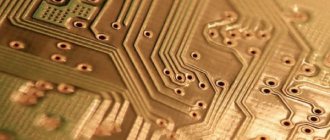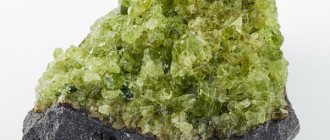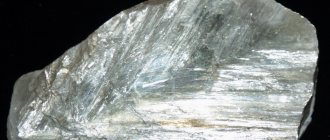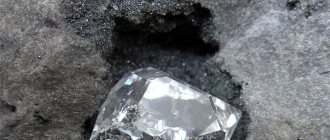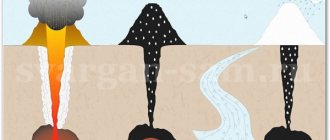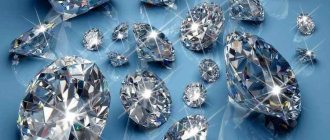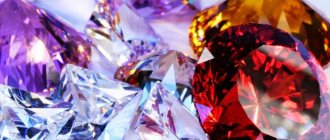Good day, dear friends! What do diamonds and the graphite lead of a pencil have in common? That's right, both of them are made of carbon atoms. However, graphite is soft, and diamond is indestructible, like real “adamant” (10 points on the Mohs scale). How can it be? And how are artificial diamonds born?
Indeed, both minerals consist of the same atoms, but their structure is completely different. In diamond, each carbon atom is located in the center of a triangular pyramid - a tetrahedron. This crystal lattice is very dense and the bonds in it are strong.
The structure of graphite is similar to a stack of coins: sheets of its crystal lattice, consisting of hexagons of carbon atoms, lie in layers. The connection between the layers is weak, they move easily. Therefore, the hardness of graphite is minimal (1 point on the Mohs scale).
Is there a way to turn dull graphite into sparkling adamant? Surprisingly, such technology exists.
WHAT IS A SYNTHETIC DIAMOND
At the end of the 18th century, scientists discovered that diamond is a form of carbon. This marked the beginning of numerous attempts to recreate the gemstone from available materials such as coal or graphite.
How did artificial diamonds come about?
Since the 19th century, many famous physicists and chemists have announced the successful completion of experiments in growing diamonds. True, none of these statements have been documented.
Only in 1927, the Soviet physicist O. Leypunsky made a breakthrough by calculating the conditions necessary for the process. Further research and experiments were carried out in parallel in the USSR, USA and Switzerland.
Synthetic diamond
HPHT and CVD
The first working installation for crystal synthesis was created and patented by the Swede Balthasar Platen. He learned his method from nature.
Natural diamonds are formed at depth, in the hot mantle of the earth's crust with a temperature of more than 1000°C and a pressure of about 50,000 atmospheres.
Platen recreated similar conditions: a cell with nickel, cobalt and iron was heated and pressed with a multi-ton press. In this case, metals acted as a catalyst, and presses simulated pressure of thousands of atmospheres.
This method is called HPHT (High Pressure High Temperature) - high pressure, high temperature. The method is imperfect, but simple and inexpensive. Today it is used for the mass production of industrial diamonds and diamond dust.
In the 60s of the 20th century, a more advanced method was invented: CVD (Chemical vapor deposition) - chemical vapor deposition. The essence of the technology is the crystallization of diamonds from hydrocarbon gas onto a substrate grown by the HPHT method. CVD allows for the creation of larger, purer crystals.
HPHT
Nano diamonds
In addition to HPHT and CVD, there are other, more narrowly focused technologies:
- detonation synthesis of diamonds - high temperatures and pressures are obtained due to the detonation of graphite. As a result of the decomposition of carbon-containing substances, nanocrystals are formed;
- ultrasonic synthesis of nanodiamonds - allows you to synthesize microcrystals from a suspension of graphite in an organic liquid at normal pressure and room temperature.
We recommend: FIANIT - a laser part and a “poor man’s diamond”
Similarities and differences
For a long time, HPHT diamonds and CVD diamonds differed from natural ones in size - under artificial conditions it was impossible to grow a stone larger than a carat. But many companies continue to work to eliminate this shortcoming.
Nano diamonds
Today, stones with the following characteristics are grown under artificial conditions:
| size | 6 or more carats |
| hardness | 10 on the Mohs scale |
| refractive index of light | 2,417 — 2,419 |
| color | D, E, F |
| purity | from pure IFs to technical SIs |
| type | mostly II (less than 0.001% nitrogen) |
Artificial diamonds have differences from natural ones:
- “artificial” may have metal inclusions left over from production;
- on colored stones you can see growth sectors that appear due to accelerated crystallization processes;
- Natural and artificial crystals luminesce differently in UV rays.
These differences can only be seen with specialized equipment. Therefore, suppliers and sellers of artificial diamonds are required to indicate on the product tags information about the origin of the crystals.
The price per carat depends on the properties of each stone, but in any case, the cost of even the best synthetic diamond will be 2 times lower than a natural one.
CVD
Advantages and disadvantages of artificial diamonds:
| Advantages | Flaws |
|
|
History of minerals
In 1797, it was discovered that diamond consists of pure carbon. Since then, attempts have begun to repeat the process in the laboratory. The most successful was the work of Hannay and Moissan, in 1893 they heated them to a temperature of 3000 degrees Celsius with a high heating rate and the addition of iron. Unlike Hannay, who used a tube for heating, Moissan used an electric arc furnace with carbon rods placed inside blocks of lime.
After heating, the molten iron was quickly cooled with water. All this was done in order to ensure high pressure. Similar experiments were repeated in the future. For example, Crookes achieved success in 1909 and announced this a few years later. However, this statement was later refuted.
The first official artificial diamond was created in 1926. To create it, all the methods listed above were combined. Now this example is still kept in a museum in the United States of America.
But this was not yet a sample that could be put into mass production. The greatest contribution to the creation and development of methods for producing diamonds was made by Sir Charles Algernon Parsons - it was he who, for 40 years, tried to repeat the very first experiments of Hannay and Moissan. He was very meticulous and saved the resulting samples for further research. Later he stated that everything that had been created before was not an artificial diamond.
In 1941, General Electrics joined the development of diamond production methods. They managed to heat carbon to 3000 degrees and obtain a pressure of 5 GPa. However, they were interrupted by the Second World War, and only 10 years later they resumed work on the project. During these developments, tungsten carbide anvils were used in a hydraulic press. However, all the synthesis conditions were so uncertain that the experiments could not be repeated.
In 1954, the first artificial diamond was created that was suitable for commercial synthesis. However, it had a very small diameter, only a fraction of a millimeter, so it could not be used in jewelry, but it was well suited for industry. A description of the work on its creation was published in the most prestigious scientific journal Nature.
Since 1953, ASEA, an electronics manufacturer from Sweden, also began to independently synthesize diamonds. The work was carried out using a bulky apparatus that maintained pressure at 8.4 GPa for an hour. But they also only managed to obtain small-sized specimens.
In Korea in the eighties, a competitor appeared in the creation of diamonds - . She obtained trade secrets from General Electric and was able to synthesize synthetic diamonds in 1988. After this, China entered the market with a huge number of enterprises.
WHERE SYNTHETIC DIAMONDS ARE USED
High tech
The main areas of application of artificial diamonds are industry and high technology:
- cutting tool - artificial diamonds are one of the hardest substances;
- thermal conductors - the combination of high thermal conductivity and minimal electrical conductivity makes artificial stone indispensable as a heat sink for high-power lasers and transistors;
- optics - natural diamonds are not suitable for these purposes, as they have too many defects;
Moissanite
Jewelry industry
The technological breakthrough has raised the question of the need for jewelry and diamond mining companies to control the flow of artificial stones into the jewelry market. Now the growth of their sales is limited legally. In addition to this, some companies are opening their own production of artificial jewelry diamonds.
We recommend: CHIC, SHINE, BEAUTY | How to grow NANO-SAPHIRE
That's exactly what De Beers did. The diamond mining corporation refused to engage in diamond production for a long time. However, in 2021, she created a subsidiary, Lightbox Jewelry, which began selling artificial stones under its own brand.
Growing diamond with methane
They also use a simpler technology for the production of synthetic stone - the explosion method, which allows you to grow an artificial crystal under the influence of methane. Very often, the production of artificial diamonds occurs using two technologies. The fact is that in the first case it is possible to obtain the highest percentage yield of diamonds, but they will be very small. The second technology allows you to significantly increase the resulting synthetic stone by blowing methane under the influence of a temperature of about 1100 ºС. The explosion method makes it possible to obtain an artificial diamond of any size.
WHAT ARE ARTIFICIAL DIAMONDS CALLED?
According to the prevailing stereotype, “artificial” is something only externally similar to the original. But imitation does not always mean fake.
Nexus
Since modern grown diamonds are identical to natural ones, marketers propose replacing the established term “artificial diamond” with wording that would reflect the nature of the origin of this stone more accurately:
- "created";
- “grown in a laboratory”;
- “created in a laboratory.”
Artificially grown "diamonds"
There are other types of artificial stones. They are close in structure to diamonds, but are slightly inferior in terms of hardness characteristics and light refractive indices.
- Moissanite. In nature, it forms small colorless crystals with a diamond luster - silicon carbide. But the natural mineral is extremely rare. Therefore, when we talk about moissanite, we usually talk about artificial carbocorundum. The stone is very similar to diamond (its refractive index is even higher: 2.65 - 2.69), and the hardness is only slightly lower (8.5-9.25 on the Mohs scale). Moissanite is also heat sensitive (it changes color when heated above 65°C).
- Nexus. Stone is created by combining carbon with other components. It is almost as strong as diamond.
- cubic zirconia Created by scientists from the Physical Institute of the USSR Academy of Sciences (FIAN), after whom it was named. Cubic zirconias are used to imitate diamonds, with which they can easily be confused due to their similar refractive index (2.15-2.25).
cubic zirconia
When translated into foreign languages, cubic zirconia is often called zircon or zirconium, which is not correct, since zircon is a mineral with different physical characteristics, and zirconium is a chemical element.
Imitation diamonds
Separately, there are crystals that imitate only the appearance of a diamond. They are significantly inferior in strength and do not have a diamond shine (refractive index is less than 1.9).
- Spinel (degussite). Natural spinel is rare and has a crimson color. Therefore, to imitate diamonds, artificial stones are used, which can be given any color.
- Crystal is high quality glass.
- Swarovski rhinestones are small stones with perfectly equal edges and various optical effects.
- White sapphire is an artificial colorless sapphire with high strength.
- Rutile - its refractive index is even higher than that of diamond, however, due to the high effect of birefringence, the back edges of the crystal are clouded.
Spinel
How to make a diamond: effective and not so effective ways
In fact, to create a diamond (ideally), the following conditions must be met:
- Pressure of more than 100,000 atmospheres.
- Temperature is about 1600 degrees (or higher).
- Hundreds of thousands of years (preferably longer).
It is now possible to create diamonds artificially in a few months. However, other conditions still have to be met.
But crazy experimenters are not going to despair. Here's what they offer:
- Using a magical combination of pipe, graphite and TNT, they propose to create a tightly sealed structure. The body should be a pipe into which the remaining components must be placed. After the resulting explosion, you need to find the remains of the experiment, and these should contain diamonds.
This experiment could cost you your life! Don't put it into practice!
- The second option is much safer, but leaves doubts about the reality of getting a diamond, and not just a beautiful stone. To do this, take a high voltage source, as well as a wire, a pencil and liquid nitrogen (can be replaced with water). Separate the lead from the pencil and grip it tightly to the wire. The structure should then be frozen and then connected to a voltage source. It is claimed that immediately after passing such a discharge, the lead will turn into a diamond. This is highly doubtful, but as a very carefully conducted home experiment, it can be tried.
Thus, at the moment, creating a truly homemade method for creating diamonds is an almost impossible task. However, if you are interested in the process itself and would like to try yourself as an experimenter (perhaps together with the younger generation), then try the following method. It has been tested by time and many generations - the result is beautiful crystal structures, so similar to the beloved diamonds and other precious stones.
HOW TO GROW AN ARTIFICIAL DIAMOND AT HOME
It will not be possible to grow an artificial diamond using carbon at home, as this will require high temperatures and pressure.
We recommend: HOW TO MAKE AMBER
At much lower cost, you can create your own transparent crystal from inorganic salts, for example, potassium alum.
Alum alum can be bought at a pharmacy or soap store at a price of 220 rubles per 1 kg.
MANUFACTURING TECHNOLOGY
- Dilute a saturated alum solution in a glass jar (add salt in 400 ml of hot water until it stops dissolving).
- Filter the resulting solution through a paper filter and leave for a day. During this time, colorless crystals form at the bottom of the jar.
- Pour the solution into a clean glass container and filter it again.
- From the resulting crystals, choose the purest one and tie it to a fishing line. Tie the other end of the fishing line to a pencil or any other object that will be placed on the neck of the jar.
- The fishing line with the crystal is lowered into the solution to the middle of the level.
- The stone is kept in the solution until it reaches the desired size (up to 2-3 months). To keep the stone clean, it is advisable to periodically filter the solution.
- When the crystal reaches the desired size, it must be removed from the solution, dried, cut off the fishing line and coated with colorless varnish.
- Homemade imitation diamond is ready.
Related publications
- Defining NATURAL EMERALD
- Defining a REAL DIAMOND
- SITALL – the stone of the future for the people of the present
- FIANIT - laser part and “poor man’s diamond”
Is it possible to get a diamond from graphite?
Of course, natural diamonds are often valued much higher than those created artificially. At the same time, diamond miners receive considerable profits. However, in pursuit of their own curiosity and sometimes thirst for profit, many seek to find out whether it is possible to obtain this precious mineral artificially?
These doubts are further fueled by the fact that the composition of graphite and diamond is almost identical.
And to some extent, those who doubt it are right - a diamond can indeed be obtained through some manipulations from simple graphite. This was proven back in 1955. But for such an event it was necessary to create a temperature of 1800 degrees Celsius and a pressure of 120,000 atmospheres. Is it possible to make this easier?
